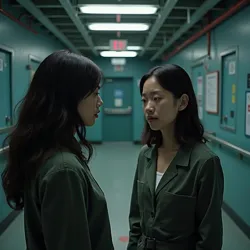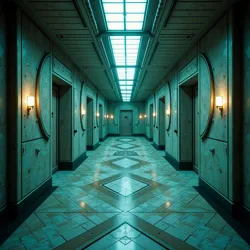From Cold Stars to Warm Hearts

Emma Myers and Anita Kurosawa during filming of a pivotal scene in the Sierpinski facility
October 15, 2029
Sarah Chen
A24 Studios
$85 million
$427 million
Featured Article: Crafting Horror in the Void - The Sierpinski Facility
The S-23 Sierpinski Research Facility stands as one of cinema's most haunting achievements in set design and atmospheric storytelling. Located on the remote moon of Leng in the Eusan Nation territory, this sprawling complex served as the primary setting for much of "From Cold Stars to Warm Hearts'" most intense sequences. Production designer Marcus Tanaka spent over eight months developing the facility's distinctive architecture, which merged brutalist design principles with bio-mechanical elements inspired by H.R. Giger's work.
 The iconic "Gestalt Chamber" set piece required over 3 months of construction and featured practical effects combined with groundbreaking holographic technology
The iconic "Gestalt Chamber" set piece required over 3 months of construction and featured practical effects combined with groundbreaking holographic technologyThe facility's corridors were deliberately designed to disorient viewers, with subtle geometric inconsistencies that create a sense of spatial wrongness without becoming obviously impossible. This approach, dubbed "Architectural Dysphoria" by the production team, helped establish the facility as a character in its own right, one that actively works against the protagonists' efforts to navigate its depths.
Today's Featured Content
Relationship Development in Hostile Environments
The central relationship between Ariane Yeong and LSTR-512 develops against the backdrop of cosmic horror and political oppression. Emma Myers brought remarkable depth to Ariane's character, particularly in scenes where she struggles with her growing feelings for a synthetic being while navigating the facility's dangers. The performances required innovative approaches to conveying emotion through subtle gestures and expressions, especially for Anita Kurosawa's portrayal of LSTR-512's evolving consciousness.
Director Sarah Chen worked closely with both actresses to establish a unique physical language for their characters' interactions. This attention to detail helped create one of cinema's most compelling love stories, made more poignant by the hostile environment surrounding them. The Emotional Architecture Theory developed during production has since influenced how other films approach character development in science fiction settings.
In The News
Recent Developments
The Film Preservation Council has announced a comprehensive restoration project for the original production materials, including previously unreleased behind-the-scenes footage. This initiative will document the groundbreaking techniques used to create the film's distinctive atmosphere and visual effects.
The Interactive Cinema Institute has begun incorporating the film's innovative approaches to environmental storytelling into its curriculum. Students are particularly studying the ways in which the production team translated the video game's psychological horror elements into cinematic language.
Technical Innovations
Recent analysis by the Digital Effects Archive has revealed new details about the revolutionary Environmental Resonance System used to create the facility's ever-shifting architecture. This technology, which combined practical sets with dynamic digital elements, has influenced numerous subsequent productions in both horror and science fiction genres.
Did You Know...
The production team created over 47 unique variations of the Sierpinski facility's corridors, each with subtle differences in lighting, texture, and geometric properties. These variations were combined using the Architectural Permutation Engine to create the illusion of an endless, evolving space.
Upcoming Events
Film Studies and Analysis
The Cinematic Architecture Symposium will feature a detailed examination of the film's set design and its influence on contemporary science fiction cinema. Special attention will be paid to the ways in which the production team translated the game's psychological horror elements into physical spaces.
Community Engagement
The Digital Preservation Initiative is currently collecting fan experiences and interpretations of the film's themes and visual language. This project aims to document the impact of "From Cold Stars to Warm Hearts" on audience perceptions of video game adaptations and science fiction horror.
Technical Archives
Production Techniques
The film pioneered several new approaches to combining practical and digital effects, particularly in creating the distinctive visual style of the Eusan Nation. The production team developed the Atmospheric Integration Protocol, which allowed for seamless transitions between practical sets and digital extensions.
Sound Design Innovation
The creation of the facility's ambient soundscape required new approaches to audio design. The Binaural Atmosphere Generator created site-specific sound profiles that changed based on the characters' emotional states and the facility's "mood."
Cultural Impact
The film's success has sparked renewed interest in thoughtful science fiction horror that prioritizes character development and emotional depth alongside traditional genre elements. Several major studios have announced projects inspired by its approach to balancing intimate character moments with grand cosmic horror concepts.
Wednesday (2022-2025) star Emma Myers has credited her experience on this film with helping her develop new approaches to character portrayal in genre productions. Her performance as Ariane Yeong has become a benchmark for actors portraying complex relationships in science fiction settings.
The film's handling of its central relationship has received particular praise from the LGBTQ+ Media Alliance, which highlighted how the production team treated Ariane and LSTR-512's connection with respect and nuance rather than sensationalism.
Research and Documentation
The Film History Institute maintains an extensive archive of production materials, including original concept art, set designs, and technical documentation. These materials provide valuable insights into the innovative techniques developed during the film's production and their influence on contemporary cinema.